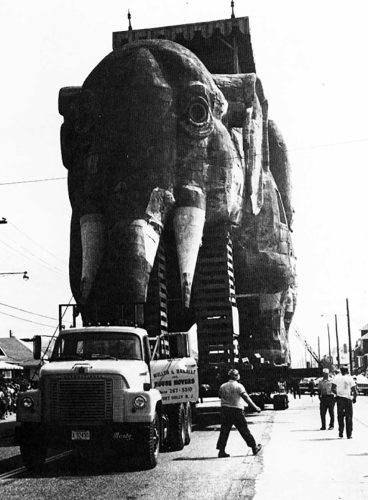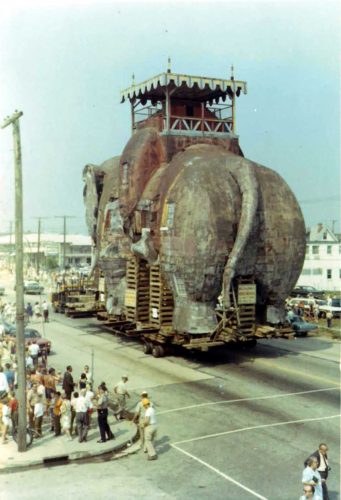A Singular Attraction
Lucy the Elephant is America’s oldest roadside attraction.

 Last summer my friend Christine and I embarked on a multi-day trek to South Jersey’s coastal nature areas and other outdoor-oriented venues, resulting in a three-part travelogue in SNJ Today.
Last summer my friend Christine and I embarked on a multi-day trek to South Jersey’s coastal nature areas and other outdoor-oriented venues, resulting in a three-part travelogue in SNJ Today.
After leaving Edwin B. Forsythe National Wildlife Refuge we headed to the Marine Mammal Stranding Center, before visiting barrier island nature preserves. Passing through Margate we decided to see New Jersey’s famous pachyderm, Lucy. After all, who could resist directional signs marked with an elephant topped by a howdah, and further proclaiming her a National Landmark?
Christine, being originally a Yorkie (yes, England), finds Americans’ ideas of what’s old to be amusing—or “simply rubbish.” By English standards Lucy is a pup. But she’s our pup. So let’s venture on, shall we?
As we turned off Ventnor Avenue onto N. Decatur last year, some dust blew off my memories’ shelves and I said, “I think Lucy is getting a spa treatment.” Little did I know she would be wrapped from toes to howdah in a giant cocoon obscuring even a glimpse of her tusks.
This is when I vowed to the readers to return after her unveiling and report on our elephant-sized findings.
 Upon our arrival this year at Lucy, Executive Director, Richard Helfant met us in the gift shop at the base of Lucy’s feet. By the way, there is not a specialized name for elephant feet—not paws or hooves—simply feet. This might possibly be the only natural history fact that this summertime fun article will impart. For those not in the know I suspect I should mention that Lucy is an elephant with a room—a “folly.”
Upon our arrival this year at Lucy, Executive Director, Richard Helfant met us in the gift shop at the base of Lucy’s feet. By the way, there is not a specialized name for elephant feet—not paws or hooves—simply feet. This might possibly be the only natural history fact that this summertime fun article will impart. For those not in the know I suspect I should mention that Lucy is an elephant with a room—a “folly.”
We discussed with Richard how America’s oldest roadside attraction came to grace Margate’s shores and her current location.
She was constructed by Philadelphia engineer and land speculator James V. Lafferty, Jr. who hired William Free to design this architectural piece of whimsy. It was constructed in 1881 at a cost of between $25,000 and $38,000, and was intended as a temporary attraction, or marketing tool, to encourage prospective buyers to purchase his land holdings.
Lucy was originally about 100 feet farther north and 100 feet closer to the shoreline, but after being buried knee-deep in sand she was moved 100 feet inland. By 1969 Lucy was a decaying shadow of her former self; she had not been intended to be a permanent structure and her functions and ownership between 1881 and 1969 were varied.
In 1887 Lafferty sold Lucy to the Gertzen family and Sophia Gertzen is responsible for having renamed the Elephant Bazaar simply “Lucy.”
Later her location was sold by her owners to developers and Lucy was unfortunately not part of the new plan. Had it not been for the Margate Civic Association’s Save the Lucy Committee’s vision, demolition would have been her destiny. (Lucytheelephant.org offers many more historic facts.)
I asked Richard how long he had been associated with Lucy and he told me, “Since I was seven years old.”

“Then did you witness her famous hundred-foot two-block move to this location?” I inquired.
He pointed out the window across Decatur. “Yes, from that corner where the gray car is parked. She creaked and jostled about. The house-moving contractors Mullen and Ranalli voided their contract’s guarantee, which promised an intact move, when they realized how frail she was. I remember when she was navigated over a curb how the noises she emitted almost made her seem alive!”
He explained that Atlantic Electric, Bell Telephone, and the cable company all had to detach wires for her six-story frame to navigate Atlantic Avenue. The 1970 move to her current location took about eight hours.
Richard has been the executive director since 2000. I asked what he likes best about his job and he replied, “The kids! Their faces when they first see Lucy. The way they talk about her as if she is alive. Well, honestly, we all talk about her that way.”
Richard, the Board, staff, and volunteers have taken the organization’s finances from the red into the black and are currently very proud to show off a newly restored Lucy.
The restoration was supposed to take eight months and cost $1.2 million, but COVID and the great increase in the price of building materials increased the total to $2.4 million and 15 months of work.
Richard hopes to carry on the legacy that Josephine Harron and Ed and Silvia Carpenter spearheaded in establishing the Save Lucy Committee.
During our guided tour with a fellow named Mortimer we learned that the only casualty during Lucy’s 1970 move was her tongue, which I suppose gave her no say about the details of her relocation.

Tour groups travel up Lucy’s spiral wooden staircases, housed within her legs, at 45-minute intervals. There are 25 stairs to climb to her belly and about 32 to the howdah. Once perched in the howdah you have achieved mahout status, and have a great view of some of southern New Jersey’s coastline and ocean. From this vantage point you can also see Margate’s water tower with its portrait of Lucy, the City’s mascot.
Mortimer is truly vested in Lucy. He was just a bit quirky but factual enough to hold the attention of our tour group. He relayed the history of her ownership as well as the storms and weather that continually challenge Lucy’s existence. He also discussed her most recent renovation and a strange overnight Airbnb fundraiser.
Mortimer mused that since Lucy predated the Statute of Liberty by three years, immigrants would have quite possibly been treated to a look at this 65-foot-tall elephant from eight miles offshore. What might they have thought about a new world with six-story-tall elephants?
Lucy lore also relates that during prohibition a green light was lit in her right eye to signal that the coast was clear for bringing contraband ashore, and a red light meant authorities represented a threat. Recently this story was confirmed by some old timers familiar with the details; the organization continues to uncover historical facts and sort them from the fiction that has arisen around Lucy.

Currently in the works is the demolition of the gift shop and the establishment of a new visitors’ center, which will allow those who can’t climb stairs to have a virtual visit with Lucy while viewing her from the outside. It will also enable the organization to provide a larger gift shop to generate the proceeds that feed the beast!
I hope that in their shop they will offer some children’s books about the natural history of elephants and their plight. And for the adults, permit me to recommend Carl Safina’s Beyond Words, What Animals Think and Feel. After all, what better way to learn about what animals experience than to explore the world of elephants?
Since the advent of the car, roadside attractions have been a part of America’s travel heritage. For the neighbors they arouse mixed reactions. Honestly, I’d rather not look out my bedroom window at Paul Bunyan or a dinosaur. But like her or not, Lucy is iconic for our region and worth a quirky tour.
There is plenty of room in the elephant for your visit. So take some time to enjoy a fun friend or family day and enter the belly of the beast!








